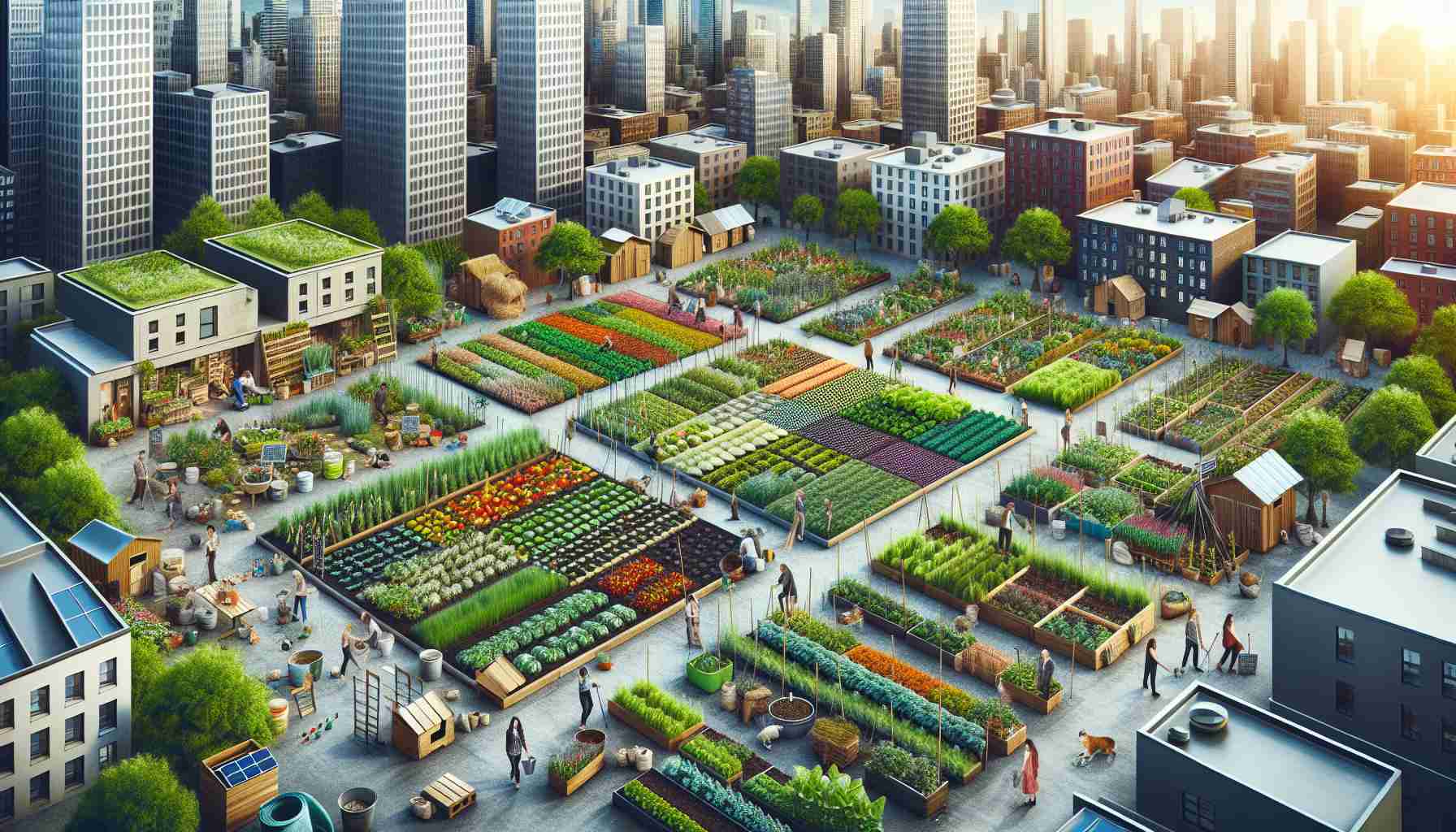Urban areas are often viewed as concrete jungles, filled with skyscrapers, bustling streets, and noise. However, within these vibrant cities lies a growing movement that aims to transform underutilized spaces into flourishing community gardens. These gardens serve not only as a source of fresh produce but also contribute to environmental sustainability, social cohesion, and mental health benefits.
One of the most compelling reasons for the rise of community gardens is their impact on food security. Many urban residents, particularly in food deserts, lack access to fresh fruits and vegetables. Community gardens provide a sustainable solution by allowing individuals to grow their own food. For instance, a study from the American Public Health Association found that community gardens can increase access to fresh produce, resulting in improved nutrition among residents. This empowerment promotes healthier eating habits and combats food insecurity in urban areas.
Additionally, community gardens contribute positively to the environment. Urban gardening helps combat the urban heat island effect by providing green spaces that cool the air, reduce stormwater runoff, and improve air quality. According to the U.S. Environmental Protection Agency, green spaces absorb carbon dioxide and other pollutants, thus contributing to a healthier environment. Moreover, these gardens encourage biodiversity by providing habitats for various species of birds, insects, and plants, supporting local ecosystems amid the urban landscape.
Beyond the environmental and nutritional aspects, community gardens play a significant role in enhancing social cohesion within neighborhoods. They serve as gathering places where residents can interact, share knowledge, and build relationships. Many community gardens are managed by local organizations that host workshops, events, and volunteer days, fostering a sense of belonging and community pride. Research published in the Journal of Community Psychology emphasizes that community gardening enhances social ties and networks, which are vital for creating resilient communities.
The mental health benefits of community gardening are also well-documented. Engaging in gardening activities has been linked to reduced stress levels and improved mental well-being. A study conducted by the University of Westminster found that participants in gardening activities experienced a significant decrease in cortisol levels, a key stress hormone. Gardening promotes physical activity and provides a creative outlet, which can be especially therapeutic for individuals dealing with anxiety or depression. The act of nurturing plants and witnessing their growth fosters a sense of accomplishment and purpose, positively impacting overall mental health.
In conclusion, community gardens are more than just patches of green in urban landscapes; they are vital spaces that promote food security, environmental health, social cohesion, and mental well-being. As cities continue to grow and confront challenges such as climate change and food access, supporting and expanding community gardening initiatives can pave the way for healthier, more sustainable urban environments. By investing in these green spaces, communities can cultivate not only plants but also a sense of unity and resilience among their residents.
Maximize Your Urban Gardening Experience: Tips, Life Hacks, and Interesting Facts
Urban gardening, particularly through community gardens, has become a vital resource for many city dwellers. Whether you’re an experienced gardener or just starting, here are some tips, life hacks, and interesting facts to enhance your urban gardening experience and make the most out of these green spaces.
1. Choose the Right Plants: Selecting plants suited for your local climate, soil type, and available sunlight is essential for a thriving garden. Consider starting with herbs like basil, mint, and rosemary, which are easy to grow and maintain, or vegetables like tomatoes and peppers, which flourish in urban settings.
2. Vertical Gardening: If space is limited, think vertically! Use trellises, wall planters, or hanging pots to maximize your growing area. This method not only saves space but also adds visual interest to your garden.
3. Composting: Implementing a composting system within your community garden can significantly reduce waste, provide natural fertilizer, and improve soil health. Encourage community members to contribute kitchen scraps and yard waste to build a robust compost heap.
4. Utilize Rainwater: Collecting rainwater in barrels can aid in irrigation while conserving municipal water supplies. Installing a simple rain barrel system can significantly reduce water costs and ensure your plants receive natural, chemical-free moisture.
5. Create a Schedule for Maintenance: Set up a gardening schedule with community members for watering, harvesting, and weeding. This ensures that maintenance responsibilities are shared, keeps the garden flourishing, and cultivates a deeper sense of responsibility and commitment among gardeners.
6. Educational Workshops: Organize workshops that teach various gardening techniques or related skills like cooking with fresh produce. By sharing knowledge, you strengthen community bonds and empower individuals with new skills that can enhance their gardening experience.
7. Connect with Local Organizations: Building partnerships with local environmental and agricultural organizations can provide resources, knowledge, and possibly grants for toolkits or seeds. Collaboration can enhance the capacity of your community garden.
Interesting Fact: Did you know that engaging with plants can significantly improve your mental health? Studies indicate that spending time in green spaces can lower depression levels and increase feelings of wellbeing. Investing your time into community gardening can positively impact both your mental health and that of your neighbors.
Did You Know? Community gardens can also play an essential role in urban biodiversity. They provide critical habitats for various pollinators such as bees and butterflies, which are essential for food production and maintaining ecological balance.
In conclusion, community gardens are more than just a source of fresh produce—they are gateways to enhancing food security, environmental health, social connections, and mental well-being in our urban environments. By applying these tips and hacks, you can nourish not only your plants but also your community.
For more resources on urban gardening and sustainable practices, check out Community Garden Organization.
The article has been updated: 2024-11-03 06:30
Here are some suggested related links:
1. Urban Gardens Web – A resource dedicated to urban gardening, featuring articles, news, and guides on creating and maintaining community gardens in urban areas.
2. Community Gardening Association – A national organization that supports community gardening efforts, offering resources, tools, and a network for garden enthusiasts.
3. Green Roofs for Healthy Cities – A platform promoting green infrastructure in urban environments, including information on community gardens and green roofs.
4. City Farmers Nursery – An online hub for city gardeners, providing resources, tips, and products for urban gardening, including community gardens.
5. The Trust for Public Land – An organization focused on creating parks and public spaces in cities, including community gardens as essential components of urban ecology.
6. American Community Gardening Association – A non-profit that champions community gardening, offering resources, support, and advocacy for urban gardening initiatives.
7. Green Belt Movement – An environmental organization focused on tree planting and community garden initiatives, particularly in urban areas, with an emphasis on sustainability.
8. Local Harvest – A website that connects people with local food sources, including farmers’ markets and community gardens, promoting the idea of growing food in urban spaces.
The article has been updated: 2024-11-06 16:00
What are the benefits of community gardens in urban areas?
Community gardens in urban spaces offer a multitude of benefits, including enhancing food security by providing access to fresh produce, fostering social connections among residents, and promoting environmental sustainability. They serve as green retreats, improving mental health and well-being while also supporting biodiversity by creating habitats for various species. Additionally, community gardens can educate individuals about gardening and healthy eating, empowering them to take charge of their food choices.







